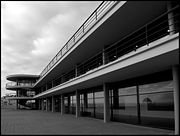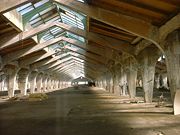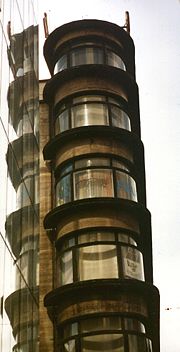Erich Mendelsohn

Erich Mendelsohn (21 March 1887 – 15 September 1953) was a German Jewish architect, known for his expressionist architecture in the 1920s, as well as for developing a dynamic functionalism in his projects for department stores and cinemas.
Contents |
Early life
Born in Allenstein (Olsztyn), East Prussia, Mendelsohn was the fifth of six children; his mother was a hatmaker and his father a shopkeeper. He attended a humanist Gymnasium in Allenstein and continued with commercial training in Berlin.
In 1906 he took up a study of national economics at the University of Munich. In 1908 he began studying architecture at the Technical University of Berlin; two years later he transferred to the Technical University of Munich, where in 1912 he graduated cum laude. In Munich he was influenced by Theodor Fischer, an architect whose own work fell between neo-classical and Jugendstil, and who had been teaching there since 1907; Mendelsohn also made contact with members of Der Blaue Reiter and Die Brücke, two groups of expressionist artists.
From 1912 to 1914 he worked as an independent architect in Munich. In 1915 he married cellist Luise Maas. Through her, he met the cello-playing astrophysicist Erwin Finlay Freundlich. Freundlich was the brother of Herbert Freundlich, the deputy director of the Kaiser Wilhelm Institut für Physikalische Chemie und Elektrochemie (now the Fritz Haber Institute of the Max Planck Society in the Dahlem district of Berlin. Freundlich wished to build an astronomical observatory suitable to experimentally confirm Einstein's Theory of Relativity.

Through his relationship with Freundlich, Mendelsohn had the opportunity to design and build the Einsteinturm ("Einstein Tower"). This relationship and also the family friendship with the Luckenwalde hat manufacturers Salomon and Gustav Herrmann helped Mendelsohn to an early success.
From then until 1918, what is known of Mendelsohn is, above all, a multiplicity of sketches of factories and other large buildings, often small format or in letters from the front to his wife.
Career
At the end of 1918, upon his return from World War I, he settled his practice in Berlin. The Einsteinturm and the hat factory in Luckenwalde established his reputation. As early as 1924 Wasmuths Monatshefte für Baukunst (a series of monthly magazines on architecture) produced a booklet about his work. In that same year, along with Ludwig Mies van der Rohe and Walter Gropius he was one of the founders of the progressive architectural group known as Der Ring.
His practice grew. In its best years, it employed as many as forty people, among them, as a trainee, Julius Posener, later a famous architectural historian. Mendelsohn's work encapsulated the consumerism of the Weimar Republic, most particularly in his shops: most famously the Schocken Department Stores. Nonetheless he was also interested in the socialist experiments being made in the USSR, where he designed the red Flag Textile Factory in 1926 (together with the senior architect of this project, Hyppolit Pretreaus). His Mossehaus newspaper offices and Universum cinema were also highly influential on art deco and Streamline Moderne.

During this time, Mendelsohn was successful both in his work and financially. In 1926, not even forty years old, he was able to buy himself an old villa. In 1928 planning began for his Rupenhorn house, nearly 4000 m², which the family occupied two years later. With an expensive publication about his generously proportioned new home, adorned with the work of Amédée Ozenfant among others, Mendelsohn became the subject of envy.

As a Jew, seeing the rise of antisemitic tendencies in Germany, he emigrated in the spring of 1933 to England. His not inconsiderable fortune was later seized by the Nazis, his name was struck from the list of the German Architects' Union, and he was excluded from the Prussian Academy of Arts.
In England he began a business partnership with Serge Chermayeff, which continued until the end of 1936. Mendelsohn had long known Chaim Weizmann, later President of Israel. At the start of 1934 he began planning a series of projects on Weizmann's behalf in Palestine and in 1935 opened a bureau in Jerusalem. In 1938, having already dissolved his London office, he took UK citizenship and changed his forename to "Eric".
From 1941 until his death Mendelsohn lived in the United States and taught at Berkeley University. Until the end of World War II his activities were limited by his immigration status to lectures and publications. He also served as an advisor to the U.S. government. For instance, in 1943 he collaborated with the U.S. Army and the Standard Oil in order to build replicas of typical German working class housing estates, which would be of key importance in acquiring the know-how and experience necessary to carry out the firebombings on Berlin.[1] In 1945 he established himself in San Francisco. From then until his death in 1953 he undertook various projects, mostly for Jewish communities.
Buildings (selected)






- Work hall of the Herrmann hat factory, Luckenwalde (1919-1920)
- Einsteinturm (Observatory on the Telegraphenberg) in Potsdam, 1917 or 1920-1921 (building), 1921-1924 (technical equipment). The building, its expressionistic form giving the impression of concrete as a building material, was mostly built in brick and then covered with plaster. Mendelsohn explained this was because of delivery problems; however, it is presumed that the real reason for the choice of building materials was problems with constructing the casing.
- Steinberg hat factory, Herrmann & Co, Luckenwalde (1921-1923) with a strict, angular form
- Mossehaus, conversion of the offices and press of Rudolf Mosse, Berlin (1921-1923)
- Schocken department store, Nuremberg (1925-1926)
- Red Flag Textile Factory, Leningrad, 1926. Mendelsohn authored the building of the power station of the factory; the other buildings were authored by S. O. Ovsyannikov, E. A. Tretyakov, and Hyppolit Pretreaus, who was the senior architect of this project. The complex of buildings of this factory is included in the List of the objects of historical and cultural heritage, issued by the government of Saint-Petersburg in 2001 (with additions of 2006).
- Extension and conversion of Cohen & Epstein department store, Duisburg (1925-1927)
- Schocken department store, Stuttgart (1926-1928). The department store, together with the Tagblatt-Turm (1924-1928) of Ernst-Otto Oßwald across the way, constituted an impressive ensemble of modern architecture, and was damaged only lightly in World War II. In 1960, the city Stuttgart demolished both, despite international protest. In its place today stands Egon Eiermann's unremarkable department store building (Galeria Kaufhof, previously Horten).
- Exhibition pavilion for the publishing house Rudolf Mosse at the "Pressa" in Cologne (1928)
- Woga-Komplex and Universum-Kino (cinema), Berlin (1925-1931)
- Schocken department store, Chemnitz 1927-1930, known for its arched front with horizontal strips of windows.
- His own home, Am Rupenhorn, Berlin (1928-1930)
- Columbus-Haus, Potsdamer Platz, Berlin (1928-1932), originally a store for Galeries Lafayette, not to be confused with the "Columbia-Haus" in Berlin-Tempelhof, which was torn down in 1938
- Jewish youth center, Essen (1930-1933)
- The De La Warr Pavilion, Bexhill-on-Sea, Sussex, England (1934). In collaboration with Serge Chermayeff.
- Cohen house, Chelsea, London (1934-1936). In collaboration with Serge Chermayeff.
- Villa Weizmann, Weizmann Institute campus, Rehovot near Tel Aviv (1935-1936)
- Built around the same time: a cluster of three buildings on the Weizmann Institute campus, presently housing high-resolution NMR, biological MRI, and the Kimmel Center for Archeology, respectively
- Hebrew University, Jerusalem (1934-1940)
- Synagogue B'Nai Amoona, now Center of Creative Arts, University City, Missouri (1946-1950)
- Maimonides Hospital, San Francisco (1946-1950)
- Park Synagogue, Cleveland Heights, Ohio (1947-1951)
Publications by Mendelsohn (in German)
- Erich Mendelsohn: Amerika. Bilderbuch eines Architekten (1976) Berlin: Nachdruck Da Capo Press, ISBN 0-306-70830-2
- Erich Mendelsohn: Rußland - Europa - Amerika. Ein architektonischer Querschnitt. (1929) Berlin
- Erich Mendelsohn: Neues Haus - Neue Welt. Mit Beiträgen von Amédée Ozenfant und Edwin Redslob (1932) Berlin. Reprinted, with an afterword by Bruno Zevi (1997) Berlin
Publications about Mendelsohn (in German)
- —, Erich Mendelsohn: Das Gesamtschaffen des Architekten. Skizzen, Entwürfe, Bauten (1930) Berlin, Reprinted by Vieweg-Verlag, Braunschweig/Wiesbaden, 1988, ISBN 3-528-18731-X
- —, Erich Mendelsohn - Dynamik und Funktion, Katalog zur Ausstellung des Instituts für Auslandsbeziehungen e. V. (1999) Hatje Canz Verlag
- Julius Posener: "Erich Mendelsohn". In: Vorlesungen zur Geschichte der neuen Architektur, special issue of Arch+ for the 75th birthday of Julius Posener. Nr. 48, December 1997, 8-13
- Ita Heinze-Mühleib: Erich Mendelsohn. Bauten und Projekte in Palästina (1934-1941)
- Sigrid Achenbach: Erich Mendelsohn 1887-1953 : Ideen - Bauten - Projekte. Catalog for an exhibit on the 100th anniversary of his birth, Beständen der Kunstbibliothek, Staatliche Museen Preussischer Kulturbesitz. Willmuth Arenhövel Verlag, ISBN 3-922912-18-4
References
- Bruno Zevi (1999) E. Mendelsohn - The Complete Works. Birkhäuser Verlag ISBN 3-7643-5975-7
- Von Eckardt, Wolf (1960) Masters of World Architecture: Eric Mendelsohn London: Mayflower. ISBN 0-8076-0230-2
- Whittick, Arnold (1956) Eric Mendelsohn (2nd Ed.). New York: F.W. Dodge Corporation
- Erich Mendelsohn: Complete Works of the Architect: Sketches, Designs, Buildings (1992 translation) Princeton Architectural Press
External links
- Erich Mendelsohn at the archINFORM database
- Hutfabrik Luckenwalde: "Meisterwerk von Mendelsohn hat wieder eine Zukunft", Kulturmagazin der Deutschen Stiftung Denkmalschutz, January 2005. (In German.)
- This article began as a translation of the corresponding article in the German Wikipedia. (Retrieved 06:19, February 11, 2005 (UTC))
References
- Oxford Dictionary of National Biography
- ↑ Quoted by Mike Davis in Chapter 3 of his work Dead Cities. The original reference, according to this online version of the chapter, is "Design and Construction of Typical German and Japanese Test Structures at Dugway Proving Grounds, Utah" 27 May 1943, by the Standard Oil Development Company.